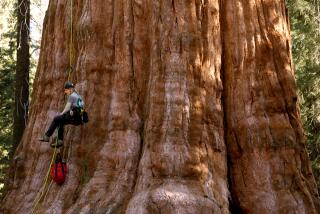A Bigger Fungus Among Us? 1,500-Acre Organism Claimed
- Share via
SEATTLE — Michigan may deserve credit for alerting the world to giant fungi, but its armillaria bulbosa looks like just another spot of root rot compared to Washington’s armillaria ostoyae.
At 38 acres, the Michigan fungus last month was acclaimed as perhaps the largest living thing on Earth, dwarfing blue whales and sequoias.
Now scientists say a fungus south of Mt. Adams in southwestern Washington is nearly 40 times bigger.
The growth of Washington’s armillaria ostoyae covers 1,500 acres. That’s 2 1/2 square miles.
“We have the claim to fame as having the world’s largest-known organism,” said Ken Russell, a forest pathologist at the state Department of Natural Resources.
It might be even bigger if not for 20 years of efforts by the state and a timber firm to eradicate the tree stumps the fungus favors.
Russell and Terry Shaw, a forest pathologist at the U.S. Forest Service Rocky Mountain Experiment Station in Ft. Collins, Colo., have studied the giant Washington fungus for two decades. Shaw estimates it is 400 to 1,000 years old.
Shaw said that while the Michigan and Washington fungi are similar, the ostoyae variety “has a greater ability to kill trees.”
Both types produce small edible mushrooms.
Giant fungi aren’t readily visible because they grow underground; the surface signs of their presence are the mushrooms and rot in the trees they attack.
The Michigan fungus was reported in the April issue of Nature magazine. Shaw dismissed that organism’s celebrity with a shrug.
“And I would suggest there are still bigger ones to find,” he said, noting there’s also a monster armillaria ostoyae near La Pine, Ore.
More to Read
Sign up for Essential California
The most important California stories and recommendations in your inbox every morning.
You may occasionally receive promotional content from the Los Angeles Times.













